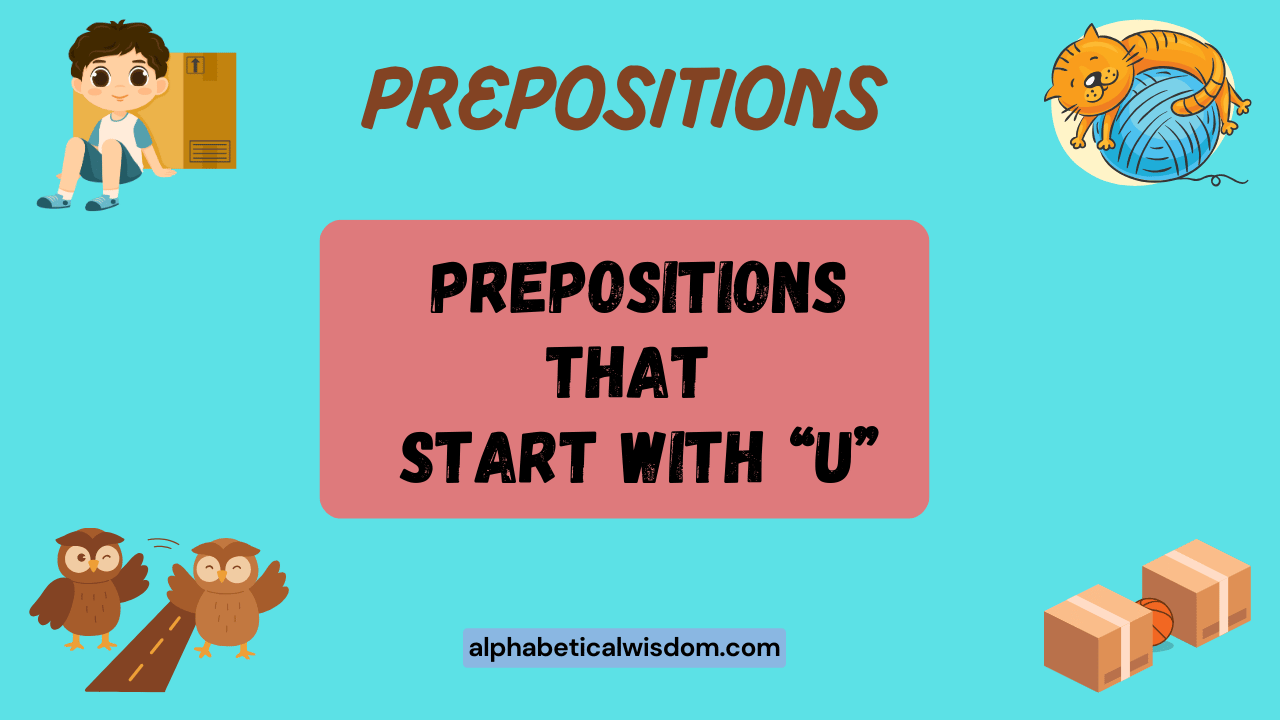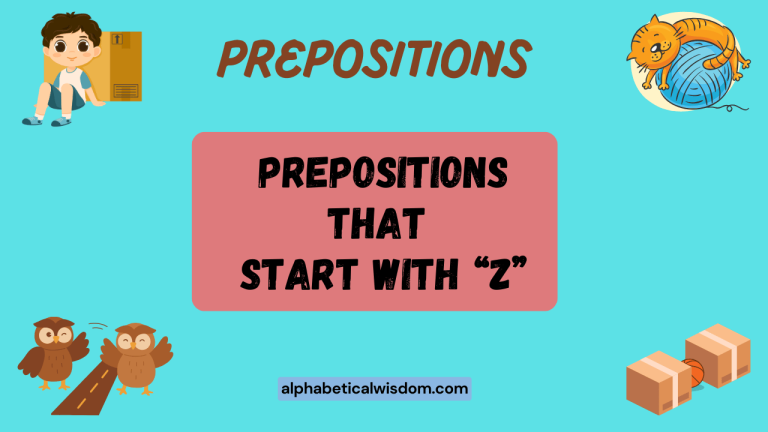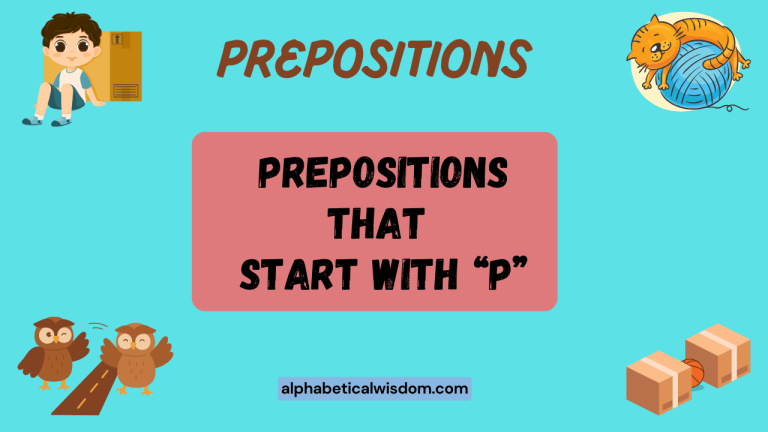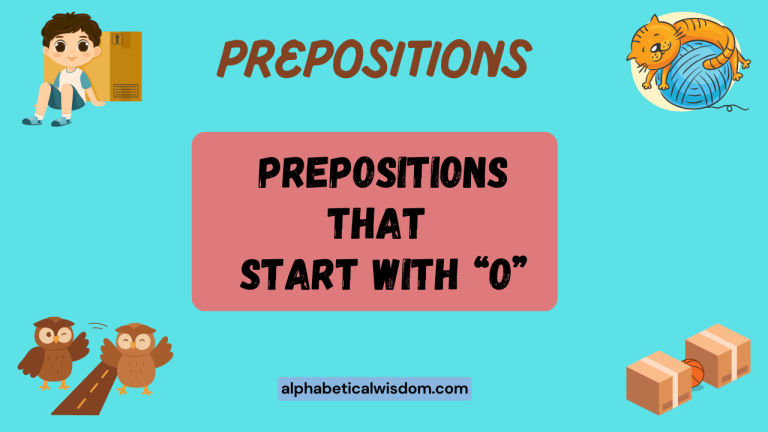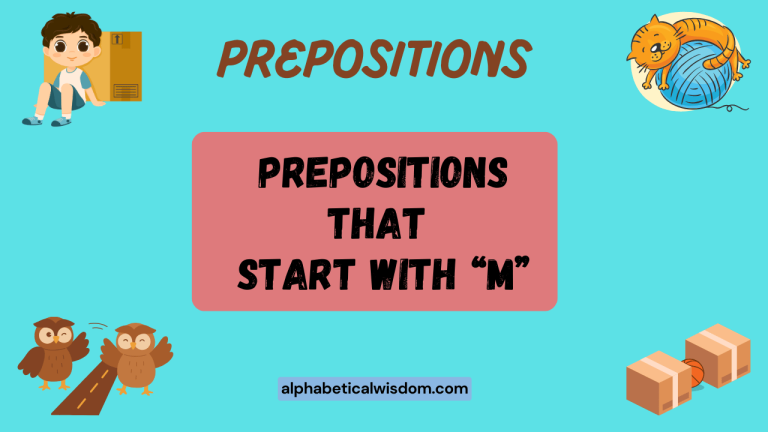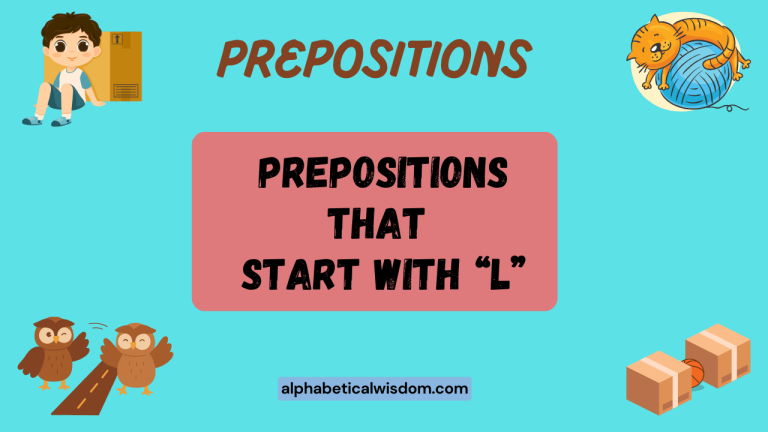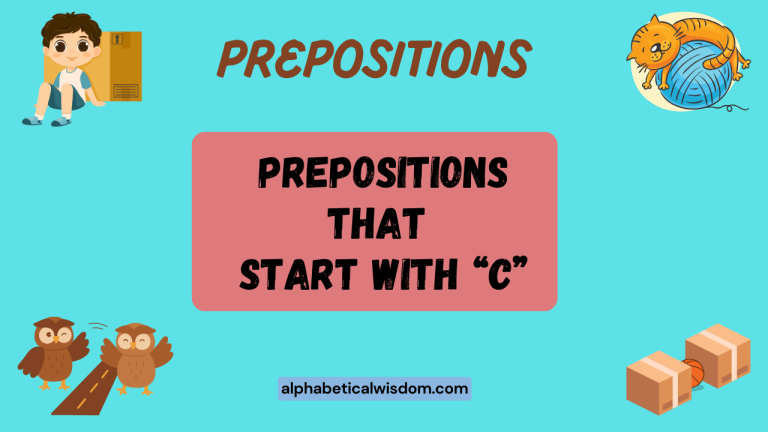Mastering Prepositions Starting With ‘U’: A Comprehensive Guide
Prepositions are essential components of the English language, acting as bridges that connect nouns, pronouns, and phrases to other parts of a sentence. Understanding prepositions is crucial for constructing clear and grammatically correct sentences.
This article focuses specifically on prepositions that begin with the letter ‘U,’ providing a detailed exploration of their meanings, usage, and common pitfalls. This comprehensive guide is designed for English language learners of all levels, from beginners seeking to build a solid foundation to advanced speakers aiming to refine their understanding and usage of these often-overlooked words.
By mastering these prepositions, you can significantly enhance your writing and speaking skills, ensuring clarity and precision in your communication.
Table of Contents
- Definition of Prepositions
- Structural Breakdown of Prepositional Phrases
- Types and Categories of Prepositions
- Examples of Prepositions Starting with ‘U’
- Usage Rules for Prepositions Starting with ‘U’
- Common Mistakes with Prepositions Starting with ‘U’
- Practice Exercises
- Advanced Topics: Nuances and Idiomatic Expressions
- Frequently Asked Questions
- Conclusion
Definition of Prepositions
A preposition is a word that connects a noun, pronoun, or noun phrase to other words in a sentence. It typically indicates the temporal, spatial, or logical relationship of the noun phrase to the rest of the sentence. Prepositions usually precede the noun or pronoun, forming what is known as a prepositional phrase. These phrases function as adjectives or adverbs, modifying other elements within the sentence.
Prepositions can be classified based on their structure and function. Simple prepositions consist of a single word, such as in, on, at, and, of course, the prepositions starting with ‘U’ that we will be focusing on here. Compound prepositions are formed by combining two or more words, such as according to, because of, and in spite of. Prepositions of time indicate when something happens, while prepositions of place specify where something is located. Understanding these distinctions is vital for accurate and effective communication.
The function of a preposition is to show the relationship between the noun or pronoun (its object) and another word or element in the sentence. This relationship can be spatial (the book is on the table), temporal (I will see you in the morning), or abstract (He is interested in music). Without prepositions, sentences would lack clarity and precision, making it difficult to convey intended meanings. Therefore, a solid grasp of prepositions is essential for mastering English grammar.
Structural Breakdown of Prepositional Phrases
A prepositional phrase consists of two main components: the preposition itself and its object. The object of the preposition is typically a noun, pronoun, or noun phrase. The entire prepositional phrase functions as a single unit, modifying another word or phrase in the sentence. The structure can be represented as follows: Preposition + (Optional Modifiers) + Object.
For example, in the sentence “The cat is sleeping under the table,” the preposition is “under,” and the object is “the table.” The entire phrase “under the table” functions as an adverb, modifying the verb “sleeping” by indicating where the cat is sleeping. The modifiers, when present, usually come between the preposition and the object, providing additional information about the object. For instance, in the phrase “up a very steep hill,” “a very steep” modifies the noun “hill”.
Understanding the structure of prepositional phrases is crucial for correctly interpreting and constructing sentences. By recognizing the role of each component, you can avoid common grammatical errors and ensure that your writing is clear and concise.
Pay close attention to the order of words within the phrase and the relationship between the preposition and its object to master this fundamental aspect of English grammar. Recognizing prepositional phrases also helps in diagramming sentences and understanding the relationships between different parts of speech.
Types and Categories of Prepositions
Prepositions can be categorized based on their meaning and function. The most common categories include prepositions of time, place, direction, and manner. Some prepositions can belong to multiple categories depending on the context in which they are used. Understanding these categories can help you choose the correct preposition for a given situation.
Prepositions of Time
These prepositions indicate when something happens. Examples include until (which starts with ‘U’), at, on, in, before, after, and during. They specify the temporal relationship between events or actions.
Prepositions of Place
These prepositions indicate where something is located. Examples include under, underneath, up, upon, at, on, in, above, below, beside, and between. They specify the spatial relationship between objects or entities.
Prepositions of Direction
These prepositions indicate movement or direction. Examples include up, to, from, into, onto, through, and across. They describe the path or trajectory of an action or object.
Prepositions of Manner
These prepositions describe how something is done. Examples include by, with, in, and on. They specify the way in which an action is performed.
It’s important to note that some prepositions can fit into multiple categories depending on the context. For example, “in” can be a preposition of time (in the morning) or a preposition of place (in the room). Similarly, “on” can indicate time (on Monday) or place (on the table). Understanding these nuances is crucial for mastering the use of prepositions.
Examples of Prepositions Starting with ‘U’
This section provides detailed examples of prepositions that start with the letter ‘U,’ including under, underneath, until, unto, up, and upon. Each preposition is illustrated with multiple sentences to demonstrate its various uses and meanings. Understanding these examples will help you grasp the nuances of each preposition and use them correctly in your own writing and speaking.
Under
The preposition “under” typically indicates a position that is below something else. It can also imply concealment or subordination.
It is one of the most commonly used prepositions starting with ‘U’.
- The cat is sleeping under the chair.
- The children hid under the bed during the game.
- The temperature is under zero degrees Celsius.
- He felt a lot of pressure under the new management.
- The document was filed under “Confidential.”
Underneath
The preposition “underneath” is similar to “under” but often implies a closer or more direct proximity. It suggests that one thing is directly below another, often touching or very close to it.
It is often interchangeable with ‘under’.
- The treasure was buried underneath the old oak tree.
- There was a layer of ice underneath the snow.
- She found a spider underneath her pillow.
- The mechanic checked underneath the car for any damages.
- The roots of the tree extended far underneath the surface.
Until
The preposition “until” indicates a point in time up to which something continues. It specifies the duration of an action or state, marking the end point.
It is exclusively used in the context of time.
- I will wait here until you return.
- The store is open until 9 PM.
- He worked on the project until he completed it.
- The rain continued until the afternoon.
- We stayed at the party until midnight.
Unto
The preposition “unto” is an archaic form of “to” and is rarely used in modern English, except in formal or religious contexts. It typically indicates direction or giving.
- Render unto Caesar the things which are Caesar’s. (Biblical reference)
- They dedicated their lives unto the service of others.
- The inheritance was passed down unto the next generation.
- He devoted himself unto his studies.
- Forgiveness is granted unto those who repent.
Up
The preposition “up” indicates movement to a higher position or location. It can also denote direction or progress.
It is a very versatile preposition with a wide variety of uses.
- He climbed up the ladder.
- She walked up the hill.
- The price of gas went up again.
- They are up for the challenge.
- The balloon floated up into the sky.
Upon
The preposition “upon” is a more formal or literary version of “on.” It often implies a sense of formality or emphasis. It can also be used to indicate something happening immediately after something else.
- Once upon a time, there was a princess.
- They agreed upon a solution to the problem.
- He insisted upon seeing the manager.
- The responsibility falls upon your shoulders.
- Upon hearing the news, she burst into tears.
Underneath Examples Table
The following table provides more examples of the preposition “underneath” used in various contexts. This will help illustrate the versatility of “underneath” and solidify your understanding of its usage.
| Example Sentence | Context |
|---|---|
| The cat hid underneath the sofa. | Location/Position |
| There’s a whole world underneath the ocean’s surface. | Hidden place |
| He found an old coin underneath the floorboards. | Discovery |
| The roots of the tree spread underneath the garden. | Extension |
| She wore a warm sweater underneath her coat. | Layering |
| The secret tunnel ran underneath the castle. | Concealment |
| They discovered a cave underneath the mountain. | Exploration |
| The plumbing pipes are located underneath the sink. | Infrastructure |
| The foundation of the building lies underneath the ground. | Support system |
| A complex ecosystem thrives underneath the forest canopy. | Ecology |
| The children built a fort underneath the large oak tree. | Play |
| She placed a protective layer underneath the delicate fabric. | Protection |
| The river flowed silently underneath the ancient bridge. | Nature |
| He felt a sense of unease underneath his confident exterior. | Emotion |
| The old city was buried underneath layers of sediment. | History |
| She stored her valuables underneath the loose tile. | Storage |
| The intricate network of tunnels extended underneath the city. | Infrastructure |
| The lava flowed underneath the solidified crust. | Geology |
| He felt a deep sadness underneath his cheerful facade. | Emotion |
| The wiring was carefully concealed underneath the panel. | Concealment |
| The soldiers dug a bunker underneath the battlefield. | Warfare |
| A hidden spring bubbled underneath the rocks. | Nature |
| The ancient ruins lay hidden underneath the dense jungle. | History |
| She tucked the letter underneath her pillow for safekeeping. | Storage |
| The roots of the mangrove trees spread underneath the shallow water. | Ecology |
Until Examples Table
The following table provides more examples of the preposition “until” used in various contexts. This will further illustrate the versatility of “until” and solidify your understanding of its usage.
| Example Sentence | Context |
|---|---|
| The library is open until 8 PM on weekdays. | Time/Business Hours |
| We waited until the rain stopped to go outside. | Delay/Weather |
| The contract is valid until the end of the year. | Duration/Legal |
| He practiced the piano until his fingers were sore. | Effort/Persistence |
| She studied until she felt confident about the exam. | Preparation |
| The ceasefire will remain in effect until further notice. | Politics/Negotiation |
| They postponed the meeting until next week. | Scheduling |
| The store will hold the item for you until tomorrow. | Customer Service |
| The children stayed awake until Santa Claus arrived. | Tradition/Holiday |
| The effects of the medication will last until midnight. | Health/Medicine |
| I will keep this secret until the right moment. | Confidentiality |
| The project will remain confidential until its official launch. | Business/Secrecy |
| The food will stay warm until lunchtime. | Practicality |
| He continued to search until he found what he was looking for. | Determination |
| The investigation will remain open until all leads are exhausted. | Law Enforcement |
| The subscription is valid until the expiration date. | Subscription |
| She refused to give up until she achieved her goal. | Persistence |
| The exhibition will be on display until the end of the month. | Arts/Culture |
| The offer is available until supplies last. | Sales/Promotion |
| They will continue negotiations until they reach an agreement. | Diplomacy |
| The dam will hold back the water until the flood subsides. | Engineering |
| The experiment will run until the results are conclusive. | Science |
| He will remain in his position until a replacement is found. | Employment |
| The warranty is valid until two years from the date of purchase. | Warranty |
| She will stay with her family until she finds a new apartment. | Personal Situation |
Up Examples Table
The following table provides more examples of the preposition “up” used in various contexts. This will further illustrate the versatility of “up” and solidify your understanding of its usage.
| Example Sentence | Context |
|---|---|
| He looked up at the stars. | Direction |
| The balloon floated up into the sky. | Movement |
| She climbed up the stairs. | Ascent |
| Prices are going up. | Increase |
| He is up for the challenge. | Readiness |
| They built a house up on the hill. | Location |
| She tidied up her room. | Cleaning |
| The company is scaling up its production. | Business |
| He woke up early in the morning. | Time |
| She wrapped up the present carefully. | Action |
| He signed up for the course. | Enrollment |
| The team geared up for the final match. | Preparation |
| They summed up the main points of the discussion. | Summary |
| She looked up the word in the dictionary. | Reference |
| He backed up the data on an external hard drive. | Backup |
| The soldiers lined up for inspection. | Order |
| She made up a story to explain her absence. | Explanation |
| The detectives followed up on the new lead. | Investigation |
| He used up all the milk. | Consumption |
| She brought up the issue during the meeting. | Discussion |
| The runner sped up towards the finish line. | Speed |
| He stepped up to the challenge and took on the project. | Responsibility |
| The artist drew up a sketch of the landscape. | Creation |
| She set up a new business after years of planning. | Establishment |
| They patched up their differences and became friends again. | Reconciliation |
Usage Rules for Prepositions Starting with ‘U’
Using prepositions correctly requires understanding their specific meanings and the contexts in which they are appropriate. Each preposition has its own set of rules and nuances that must be considered.
This section outlines the usage rules for the prepositions starting with ‘U,’ providing guidance on how to use them effectively.
Under and Underneath
Both “under” and “underneath” indicate a position below something else. While they are often interchangeable, “underneath” can imply a closer or more direct proximity.
Use “under” for general positions and “underneath” when emphasizing the direct placement below something.
- Correct: The cat is under the table.
- Correct: The cat is underneath the table.
Until
“Until” indicates a point in time up to which something continues. It is used to specify the duration of an action or state.
Ensure that the context involves a time frame or a specific event marking the end point.
- Correct: I will wait here until you return.
- Incorrect: I will wait here under you return.
Unto
“Unto” is an archaic form of “to” and is primarily used in formal or religious contexts. In modern English, “to” is generally preferred.
Use “unto” sparingly and only in appropriate settings.
- Correct: Render unto Caesar the things which are Caesar’s.
- Modern Equivalent: Give to Caesar what belongs to Caesar.
Up
“Up” indicates movement to a higher position or location. It can also denote direction or progress.
Be mindful of the idiomatic uses of “up” in phrasal verbs and expressions.
- Correct: He climbed up the ladder.
- Correct: The price of gas went up.
Upon
“Upon” is a more formal or literary version of “on.” It often implies a sense of formality or emphasis. It can also be used to indicate something happening immediately after something else.
Use “upon” in formal writing or when seeking to add emphasis.
- Correct: Once upon a time, there was a princess.
- Correct: Upon hearing the news, she burst into tears.
Understanding these usage rules will help you avoid common errors and use prepositions starting with ‘U’ with confidence and accuracy. Pay attention to the context of your sentences and choose the preposition that best conveys your intended meaning.
Remember to consult a dictionary or grammar guide if you are unsure about the correct usage of a particular preposition.
Common Mistakes with Prepositions Starting with ‘U’
Even experienced English speakers sometimes make mistakes with prepositions. This section highlights common errors associated with prepositions starting with ‘U’ and provides corrected examples to help you avoid these pitfalls.
Confusing Under and Underneath
While “under” and “underneath” are often interchangeable, using them incorrectly can lead to awkward phrasing. Remember that “underneath” implies a closer or more direct proximity.
- Incorrect: The document is underneath the file. (Less common, “under” is preferred in this context)
- Correct: The document is under the file.
- Correct: The pipes are underneath the house. (Implies directly below)
Misusing Until
A common mistake is using “until” to indicate location instead of time. “Until” should only be used to specify the duration of an action or state.
- Incorrect: I walked until the store.
- Correct: I walked to the store.
- Correct: I will wait until 5 PM.
Overusing Unto
“Unto” is an archaic form of “to” and should not be used in modern English unless in formal or religious contexts. Using it in everyday conversation can sound unnatural.
- Incorrect: I gave the book unto him.
- Correct: I gave the book to him.
Incorrect Use of Up
“Up” can be misused if not paired correctly with verbs or when used in contexts where it doesn’t fit the intended meaning.
- Incorrect: He fell up the stairs.
- Correct: He fell down the stairs.
- Correct: He walked up the stairs.
Interchanging Upon and On
While “upon” and “on” can often be used interchangeably, using “upon” in informal contexts can sound overly formal. Choose “on” for everyday situations and “upon” for more formal or literary settings.
- Incorrect: I sat upon the chair. (Sounds overly formal)
- Correct: I sat on the chair.
- Correct: The decision was based upon careful consideration. (Appropriate in formal writing)
By being aware of these common mistakes, you can improve your accuracy and fluency in English. Pay attention to the context of your sentences and choose the preposition that best conveys your intended meaning.
Regularly review and practice these rules to reinforce your understanding.
Test your understanding of prepositions starting with ‘U’ with these practice exercises. Choose the correct preposition to complete each sentence. Answers are provided at the end of the section. Identify and correct the errors in the following sentences.Practice Exercises
Exercise 1: Fill in the Blanks
Exercise 2: Multiple Choice
Exercise 3: Error Correction
Answer Key
Exercise 1: Fill in the Blanks
Exercise 2: Multiple Choice
Exercise 3: Error Correction
Advanced Topics: Nuances and Idiomatic Expressions
For advanced learners, understanding the nuances and idiomatic expressions involving prepositions starting with ‘U’ can further refine their language skills. This section explores some of these complexities, providing insights into how these prepositions are used in more sophisticated contexts.
Idiomatic Uses of “Up”
The preposition “up” is frequently used in idiomatic expressions and phrasal verbs, often with meanings that are not immediately obvious. Understanding these expressions is crucial for comprehending spoken and written English.
- Up to: Indicating a limit or responsibility (It’s up to you to decide.)
- Up against: Facing a challenge or difficulty (We are up against a tough opponent.)
- Up for: Willing to do something (Are you up for a game of tennis?)
- Up in the air: Uncertain or undecided (The plans are still up in the air.)
Formal vs. Informal Use of “Upon”
As mentioned earlier, “upon” is a more formal version of “on.” However, there are certain situations where “upon” is preferred, even in modern English. These often involve formal writing or legal contexts.
- Legal documents: “Upon receipt of this notice…”
- Formal speeches: “I call upon you to…”
- Literary works: “Once upon a time…”
Subtleties of “Under” and “Underneath”
While often interchangeable, the choice between “under” and “underneath” can sometimes depend on the level of detail you want to convey. “Underneath” can imply a closer or more direct proximity, while “under” is more general.
Consider the specific context when choosing between these two prepositions.
- “The roots of the tree spread under the ground.” (General location)
- “The roots of the tree spread underneath the pavement.” (More specific, implying direct contact)
By exploring these advanced topics, you can gain a deeper understanding of prepositions starting with ‘U’ and use them with greater precision and confidence. Pay attention to the context in which these prepositions are used and continue to expand your knowledge of idiomatic expressions to further enhance your language skills.
Frequently Asked Questions
This section addresses common questions about prepositions starting with ‘U,’ providing clear and concise answers to help you
resolve any remaining confusion.
What is the difference between “under” and “below”?
“Under” and “below” both indicate a position lower than something else, but “below” often implies a greater distance or a more general sense of being lower. “Under” usually suggests direct vertical alignment, whereas “below” can refer to something that is generally lower but not necessarily directly beneath.
Example: “The cat is under the table.” (Directly beneath)
Example: “The temperature is below zero.” (Generally lower on a scale)
Can “until” be used at the beginning of a sentence?
Yes, “until” can be used at the beginning of a sentence, but it is often followed by a comma to separate the dependent clause from the main clause.
Example: “Until you finish your homework, you cannot watch TV.”
Is it ever correct to say “underneath of”?
No, “underneath of” is generally considered incorrect. The correct preposition is simply “underneath.”
Incorrect: “The treasure was buried underneath of the tree.”
Correct: “The treasure was buried underneath the tree.”
How do I know when to use “upon” instead of “on”?
Use “upon” in formal writing, legal documents, or when you want to add emphasis. In most everyday situations, “on” is perfectly acceptable.
“Upon” can sound overly formal in casual conversation.
Formal: “The decision was based upon careful consideration.”
Informal: “The book is on the table.”
What are some common phrasal verbs using “up”?
Some common phrasal verbs using “up” include “wake up,” “look up,” “give up,” “speed up,” and “set up.” These verbs often have meanings that are not immediately obvious from the individual words.
- Wake up: To stop sleeping
- Look up: To search for information
- Give up: To stop trying
- Speed up: To increase speed
- Set up: To establish or arrange
These frequently asked questions should help clarify any lingering doubts you may have about prepositions starting with ‘U.’ If you have further questions, consult a comprehensive grammar guide or seek assistance from an English language expert.
Conclusion
Mastering prepositions, including those that start with the letter ‘U,’ is essential for clear and effective communication in English. This comprehensive guide has provided a detailed exploration of prepositions such as under, underneath, until, unto, up, and upon, covering their definitions, usage rules, common mistakes, and advanced nuances.
By understanding the specific meanings and contexts in which these prepositions should be used, you can avoid common errors and enhance the precision of your writing and speaking. The practice exercises and examples provided in this guide offer valuable opportunities to reinforce your knowledge and develop confidence in your ability to use these prepositions correctly.
Remember that language learning is an ongoing process. Continue to practice and expand your understanding of prepositions and other grammatical concepts to further improve your English language skills.
With dedication and consistent effort, you can achieve fluency and communicate effectively in any situation.
